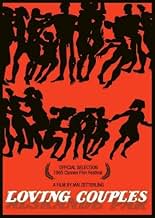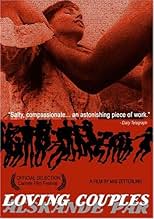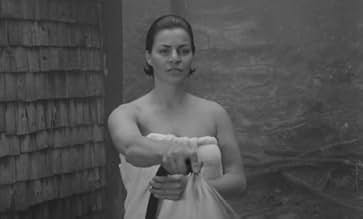1914, Stockholm. Trois femmes sur le point d'accoucher se rendent à l'hôpital. De conditions sociales diverses, Agda, Adele et Angela se remémorent leur enfance, leurs amours déçus et leurs ... Tout lire1914, Stockholm. Trois femmes sur le point d'accoucher se rendent à l'hôpital. De conditions sociales diverses, Agda, Adele et Angela se remémorent leur enfance, leurs amours déçus et leurs illusions perdues..1914, Stockholm. Trois femmes sur le point d'accoucher se rendent à l'hôpital. De conditions sociales diverses, Agda, Adele et Angela se remémorent leur enfance, leurs amours déçus et leurs illusions perdues..
- Réalisation
- Scénario
- Casting principal
- Récompenses
- 1 nomination au total
Jan-Erik Lindqvist
- Peter von Pahlen
- (as Jan-Eric Lindquist)
Avis à la une
Both in the ambiance and in its women's themes in this movie you can see unequivocally Bergman's influences. In particular It recalls Bergman's SECRETS OF WOMEN (1952)for the cast ( It's almost the same!)and for its episodic structure. The psychological search on women universe is another important link.
Anyway, although Mai Zetterling had abused it in her movies, I think that the flashback use is very interesting in this movie. It becomes, with the editing help, a concrete tragic matter and not only a way to tell the story. I give it a 6.
Anyway, although Mai Zetterling had abused it in her movies, I think that the flashback use is very interesting in this movie. It becomes, with the editing help, a concrete tragic matter and not only a way to tell the story. I give it a 6.
Comparisons to Bergman are inevitable as there are many similarities - the themes (resembling those in Brink of Life and Smiles of a Summer Night), cast (Harriet Andersson, Gunnar Björnstrand, and Eva Dahlbeck), and even cinematographer (the immortal Sven Nykvist). However, Mai Zetterling makes this film her own, showing a distinctly female point of view in this story of three women about to give birth at a hospital. We see misogyny in the various patriarchal figures, one of whom is a pedophile, but we see that even in a male-dominated world, women are empowered in their sexuality. This includes lesbian attraction, romps in the woods, becoming pregnant out of wedlock, and marrying a gay man to conceal the true father. It's pretty daring stuff for 1964. The real theme seems to be to show "loving couples" as they actually are, and how the world works behind a veneer of respectability.
The film is extremely strong in its first half with some gorgeous scenes outdoors, including a flashback to a funeral in a stunning birch forest, and a walk through flowering orchards at a girl's boarding school. They provide quite a contrast to the scenes in the hospital, with those squeaky gurney wheels rattling down halls that "look like prison" as a doctor puts it, and images looking up from the patient's perspective. Through flashbacks we gradually come to understand the three women's stories, and how their lives intersect, but unfortunately the plot unravels a bit as it plays out, getting messy and harder to follow than it should have been. It's a very good film, one with lots of beautiful moments and one I enjoyed, but could have been even better with stronger storytelling.
The film is extremely strong in its first half with some gorgeous scenes outdoors, including a flashback to a funeral in a stunning birch forest, and a walk through flowering orchards at a girl's boarding school. They provide quite a contrast to the scenes in the hospital, with those squeaky gurney wheels rattling down halls that "look like prison" as a doctor puts it, and images looking up from the patient's perspective. Through flashbacks we gradually come to understand the three women's stories, and how their lives intersect, but unfortunately the plot unravels a bit as it plays out, getting messy and harder to follow than it should have been. It's a very good film, one with lots of beautiful moments and one I enjoyed, but could have been even better with stronger storytelling.
A cynical view of marriage and love relationships in Sweden in 1914. In a totally patriarchal society women are left to use sex and motherhood as a form of power, which effectively gives them a substantial slice of influence but does not bring them any happiness.
If women's destiny is to seek love, as one of the characters says, we don't see it at all in this film. It is forbidden to them by the established social model.
Due to Nykvist's beautiful cinematography and a lot of excellent actors that we are used to see in Bergman's movies, this would even seem, at first glance, to be a film by this director. But, unlike Bergman, who always imprints a strong ethical sense on his stories, here we are at the opposite end of the spectrum, a complete cynicism when it comes to human and social values. This is a real world, a dog world and not a principled world.
A pleasant surprise.
If women's destiny is to seek love, as one of the characters says, we don't see it at all in this film. It is forbidden to them by the established social model.
Due to Nykvist's beautiful cinematography and a lot of excellent actors that we are used to see in Bergman's movies, this would even seem, at first glance, to be a film by this director. But, unlike Bergman, who always imprints a strong ethical sense on his stories, here we are at the opposite end of the spectrum, a complete cynicism when it comes to human and social values. This is a real world, a dog world and not a principled world.
A pleasant surprise.
There is no doubt that the Swedish actress Mai Zetterling, in her feature-length directing debut, had Ingmar Bergman in her mind: the cast is full of Bergman veterans, the cinematography is by the emblematic Bergman collaborator Sven Nykvist, and the whole style of the movie is modelled on her famous compatriot. Technically, the imitation is accurate: the film is well-made, the acting is fine, and I liked how Zetterling contrasted three different types of women - one happy all the time, one never happy, one somewhere in between. But the stories are too long and meandering, and for a movie so heavily dependent on flashbacks (about 80% of the running time), the flashbacks themselves are not especially revealing. **1/2 out of 4.
The story of three women from different, but related, backgrounds about to give birth in a hospital in Sweden around the start of World War I.
Via inter-cut flashbacks we are shown how they ended up in their situation.
Often beautiful Sven Nykvist photo and many great directorial flourishes from director Mai Zetterling makes this a treat.
The parallels with Bergman are many. For instance, apart from Mr. Nykvist, many of the actors have appeared in various Bergman productions, the themes dealt with here are very similar to various Bergman films, and so on. Dissimilar enough to be interesting though.
Has some very interesting scenes that I would imagine were very controversial at the time, such as two gay men frolicking and getting mock-married in a church, a graphic shot of a baby's birth, some female nudity, a lesbian kiss, etc..
Via inter-cut flashbacks we are shown how they ended up in their situation.
Often beautiful Sven Nykvist photo and many great directorial flourishes from director Mai Zetterling makes this a treat.
The parallels with Bergman are many. For instance, apart from Mr. Nykvist, many of the actors have appeared in various Bergman productions, the themes dealt with here are very similar to various Bergman films, and so on. Dissimilar enough to be interesting though.
Has some very interesting scenes that I would imagine were very controversial at the time, such as two gay men frolicking and getting mock-married in a church, a graphic shot of a baby's birth, some female nudity, a lesbian kiss, etc..
Le saviez-vous
- AnecdotesMai Zetterling's directorial debut.
- Citations
Dr. Jacob Lewin: I can't do much unless you take your pants off and lie down.
- ConnexionsFeatured in Vielleicht bin ich wirklich eine Zauberin (1989)
- Bandes originalesBagni di Lucca
Composed by Giuseppe Manente (1903)
Meilleurs choix
Connectez-vous pour évaluer et suivre la liste de favoris afin de recevoir des recommandations personnalisées
- How long is Loving Couples?Alimenté par Alexa
Détails
- Durée1 heure 58 minutes
- Couleur
- Mixage
- Rapport de forme
- 1.66 : 1
Contribuer à cette page
Suggérer une modification ou ajouter du contenu manquant

Lacune principale
By what name was Les amoureux (1964) officially released in India in English?
Répondre




































